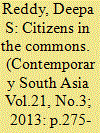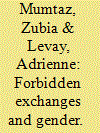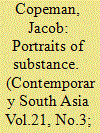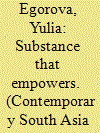|
|
|
Sort Order |
|
|
|
Items / Page
|
|
|
|
|
|
|
| Srl | Item |
| 1 |
ID:
124954


|
|
|
|
|
| Publication |
2013.
|
| Summary/Abstract |
The contemporary Bangladeshi cinema is stained red by the enthusiastic use of fake blood that erupts from bodies pictured in fist fights, gun battles and sword attacks. In this article, I draw on my ethnographic fieldwork in the Bangladesh film industry to illustrate the spurting of fake blood in two popular film genres: mainstream action cinema and straight-to-VCD rural crime stories (kiccha pala VCDs). I suggest that the affective intensity ascribed to blood by film insiders points to the capacity of blood to lend force to the protean and submerged discourses of contemporary Bangladesh presented in these blood-splattered genres. These film forms make use of the excessive and abject quality inherent in this bodily tissue as well as interacting with more regimented and metaphoric uses of blood in the political aesthetics of contemporary Bangladesh that they recycle and pervert.
|
|
|
|
|
|
|
|
|
|
|
|
|
|
|
|
| 2 |
ID:
124958


|
|
|
|
|
| Publication |
2013.
|
| Summary/Abstract |
This essay is based on ethnographic fieldwork conducted with the Indian community in Houston, as part of a National Institutes of Health and the National Human Genome Research Institute-sponsored ethics study and sample collection initiative entitled 'Indian and Hindu Perspectives on Genetic Variation Research'. Taking a cue from my Indian interlocutors who largely support and readily respond to such initiatives on the grounds that they will undoubtedly serve 'humanity' and the common good, I explore notions of the commons that are created in the process of soliciting blood for genetic research. How does blood become the stuff of which a civic discourse is made? How do idealistic individual appeals to donate blood, ethics research protocols, open-source databases, debates on approaches to genetic research, patents and Intellectual Property regulations, markets and the nation-state itself variously engage, limit or further ideas of the common good? Moving much as my interlocutors do, between India and the USA, I explore the nature of the commons that is both imagined and pragmatically reckoned in both local and global diasporic contexts
|
|
|
|
|
|
|
|
|
|
|
|
|
|
|
|
| 3 |
ID:
124957


|
|
|
|
|
| Publication |
2013.
|
| Summary/Abstract |
A safe, consistent blood supply in Pakistan is critical in combating maternal deaths due to haemorrhage. The dominant form of blood donation in Pakistan is a directed-replacement system. Complex sociocultural values influence from whom a recipient can receive blood. This focused ethnography aimed to investigate if, in this patriarchal society, the gender of the recipient influences who will donate blood. Data were collected from the district of Rawalpindi/Islamabad, Jhelum and Layyah in 2009 and 2012. Findings revealed that gendered notions of blood and blood donation construct reproductive blood loss as less serious than other types of blood loss. Husbands almost universally removed themselves from the process of blood procurement for their wives in the midst of a maternal health emergency. This was due to a combination of gender norms and beliefs about the power of blood, akin to the power of breast milk, to connect husbands and wives in a donor-recipient relationship that would lead to the negation of the marital contract. The inherent gendered devaluation of the lives of women was evident in the manner in which blood was procured for child-birthing women. These complex beliefs indicate that the idealized Euro-American blood system could be ineffective in this context.
|
|
|
|
|
|
|
|
|
|
|
|
|
|
|
|
| 4 |
ID:
124968


|
|
|
|
|
| Publication |
2013.
|
| Summary/Abstract |
This commentary discusses a set of essays, arguing that each examines a demand for the extraction or 'excorporation' of organic form to supplement a lack elsewhere, whether the apperception of that lack be located in the clinic, in national or regional politics, or in big data as databases come to promise the ground of inclusion and future life. Reading through and across the essays, it proposes a conceptual vocabulary rooted in a figure of 'commitment' or the 'given over', this given over opposed to an analytics of the gift. The argument is made that the body emerges as a ground for thought and action in its being given over to another, in its commitment. An analytics of commitment addresses the relation of parts and wholes in our attending to practices of excorporation and designations of sacrifice.
|
|
|
|
|
|
|
|
|
|
|
|
|
|
|
|
| 5 |
ID:
124963


|
|
|
|
|
| Publication |
2013.
|
| Summary/Abstract |
With the enactment of the Transplantation of Human Organs Act (THOA) in 1994, the Indian state sought to bring to a halt illegal organ sale and to encourage cadaver organ donation. A continuously low number of cadaveric organ donations as well as related difficulties faced by the government in banning the market lead proponents of organ sale to again argue for its legalization. Rather than examining policy discussions at the macro level, this essay argues that difficulties implementing the THOA hinge upon ways in which the option of cadaver organ donation has been 'brought to the public'. It explores ethical publicity - publicity that promotes cadaveric organ harvesting via the use of symbolic and cultural tropes - and unravels how it interacts with and addresses concerns voiced by ethical resistance; that is, resistance to cadaver organ donation that is also based upon religious or cultural resources. Consequently, this essay constructs a conversation between ethical publicity and ethical resistance, thereby questioning the relationship between rhetoric and culture, textual resources and culture as practice. This article not only reveals that the turn to organ sale might be premature, but also shows how conversations can open doors to new creative territories of embedding cadaveric organ donation in society.
|
|
|
|
|
|
|
|
|
|
|
|
|
|
|
|
| 6 |
ID:
124956


|
|
|
|
|
| Publication |
2013.
|
| Summary/Abstract |
This essay examines the way extractions of human blood - for medical donations, portrait paintings, and petitions - have come to form a significant means of political communication (particularly as a means of political protest) throughout India, focusing in particular on a case study from the south of a karate teacher and artist who, through painting multiple portraits of the Tamil Nadu Chief Minister with his blood, sought land for his karate school. The second half of the essay explores wider features of India's 'sanguinary politics', focusing in particular on ways in which publicly witnessed deployments of political activists' own blood once seemed to promise both intensification and purification of mass political idioms. It also considers how and why this promise has largely remained unfulfilled.
|
|
|
|
|
|
|
|
|
|
|
|
|
|
|
|
| 7 |
ID:
124959


|
|
|
|
|
| Publication |
2013.
|
| Summary/Abstract |
Drawing on two ethnographic examples of the sociocultural aspects of populations genetic research in India, the article explores in what ways tests aimed at assessing 'genetic differences' between populations can be viewed as enabling or disempowering for individuals, communities or nations subjected to such tests. The first builds on a response to DNA research demonstrated by the leaders of the Jewish Bene Ephraim community of Andhra Pradesh, a Dalit group who in the late 1980s declared their descent from the Lost Tribes of Israel. The second focuses on the Indian Genome Variation Consortium, a research network established in India in 2003 with the aim of mapping the country's human genetic diversity. Building upon Prainsack and Toom's theoretical concept of situated dis/empowerment, I suggest that in both case studies empowering and disempowering elements of DNA testing appear to co-constitute and co-produce each other, as they both reinforce reductionist accounts of human sociality and serve as rhetorical tools for social and political liberation.
|
|
|
|
|
|
|
|
|
|
|
|
|
|
|
|
| 8 |
ID:
124955


|
|
|
|
|
| Publication |
2013.
|
| Summary/Abstract |
In 2008, survivors of the 1984 Bhopal Gas Disaster in India undertook a 500-mile march to New Delhi, protesting a long history of governmental neglect of the survivors of the event. This is one episode of a 25-year-old organized international campaign that continues in the present. This article examines the ways in which three bodily substances - blood, hearts and ketones - were produced and circulated through the 2008 protests. Placed within a broader history of substance-politics in the region, this article suggests that these protests produced an imagination of bodily substances that surfaced messy contradictions that became difficult for the Indian State to disregard. This article also shows how these protests distanced themselves from the cynicism attached to similar modes of corporeal activism in the contemporary Indian landscape. In sum, this article traces the production of an activist corporeal counter-discourse that, for at least a time, contaminated the procedures through which the Indian State disregards the health of its marginal citizens.
|
|
|
|
|
|
|
|
|
|
|
|
|
|
|
|
|
|
|
|
|